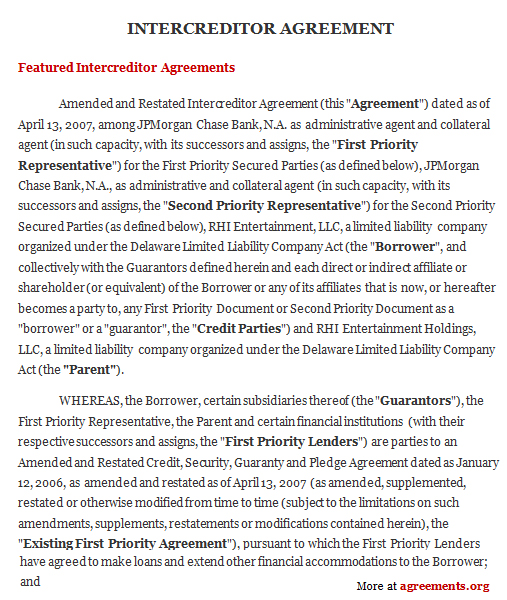An Intercreditor Agreement is a contract signed among two or more creditors, mandating and laying down in advance how their competing interests are to be settled and how to work in consonance with respect to their mutual borrower. The reason behind such an agreement between creditors is the presence of a senior and a sub-lender. Hence, it becomes important to have the interests and claims settled in advance.
Lenders are often mandated to address the priority of their loans and the security advanced with regard to another lender to the same borrower. In some instances, a simple acknowledgement that each of them is entitled to security of a specific priority over specific assets of the borrower, to the exclusion of the other lender may be sufficient. In other cases, additional restrictions on the rights of one of the lenders may be required.
In a scenario where a senior and a sub-lender is involved, the creditors typically enter into an inter-creditor agreement in order to clearly lay down their rights.
Purpose of an InterCreditor Agreement?
An intercreditor agreement is a contract which enables creditors to set forth the various lien positions and the rights and liabilities of each creditor and its effect on the other lenders. Intercreditor contracts are often used to finance companies and by lenders to establish a priority of rights inter se.
Inclusions in an InterCreditor Agreement
Apart from complex commercial and technical clauses such as lien, priority of payouts, securities advanced etc. certain standard boilerplate clauses such as dispute resolution, choice of law, severability, entire agreement, waiver and remedies need to be mentioned in the contract.
Key Terms of an InterCreditor Agreement
Key terms of an intercreditor agreement are:
- Payment restrictions and other undertakings: This clause accords priority to the different debts before the occurrence of an insolvency event.
- Permitted payments: This clause explains how the senior and junior debts need to be repaid. Typically, any payment of the principal amount with regards to the junior debt comes after the last repayment of the principal of the senior debt.
- Standstill periods: Standstill Clause provides that if an event of default has occurred pertaining to the junior debt, the junior lender is entitled to serve notice on the senior lender stating that it wishes to accelerate its debt or take steps to enforce its security.
- Subordination upon insolvency: This clause intends to postpone the junior creditor’s claims to the senior creditor’s claims in the event of winding up of the borrower organization.
Drafting of an InterCreditor Agreement?
An inter-creditor agreement sample can be drafted effectively by following the below given guidelines:
- Objective criteria for the classification of debts into senior and junior debts must be formulated and included in the contract. This criterion should be achieved only after negotiations and should be based on mutual consent.
- The securities advanced to different creditors should be properly described and the creditors’ names should be mentioned against the same.
- The names of the parties and which criteria does their debt fall in should also be mentioned.
- Applicable law becomes important, as the creditors may belong to different jurisdictions. Typically, a neutral jurisdiction should be chosen.
- Method of dispute resolution should be preferably arbitration.
- Priority of payments and the hierarchy of junior and senior debt should be carefully drafted.
- A statement confirming if the borrower is wiling to provide an equity component as part of the transaction should be captured in the contract.
Types of an InterCreditor Agreement?
The four primary types of inter-creditor agreements are as follows:
- First lien/second lien: These contracts involve two separate credit facilities, each secured by its own lien, typically on substantially the same collateral.
- Split collateral: These agreements typically involve two separate credit facilities, each usually secured by a lien on significantly the same collateral.
- Senior/mezzanine: These arrangements typically involve two separate credit facilities, one which is secured by a lien on primarily all assets and the other is either unsecured or secured solely by a pledge of a controlling interest in the borrower.
- Unitranche: These arrangements involve one credit facility secured by one lien on one pool of collateral.
Benefits of an InterCreditor Agreement?
An intercreditor agreement anticipates and attempts to remedy the problems that are presented when a borrower defaults. Simply put, the agreement states what the lien positions are and what remedies are available to subordinate lienholders in the event the borrower defaults. A major pro is that the second lienholder is offered the right to purchase at par the first lienholder’s claim, in order to secure payment on its claim. As opposed to fair market value, “at par” means face value.
An intercreditor agreement enables the creditors to lay down their rights and obligations in a defined document and prevents disputes from arising later on. However, despite having clearly written down terms and conditions, there are occasions for disputes to arise. A well-drafted arbitration clause with a neutral venue of arbitration should be included in the contract to resolve disputes.
Sample Intercreditor Agreement
A sample of the agreement can be downloaded from below.
